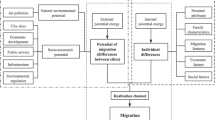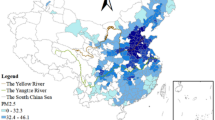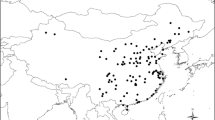Abstract
Population migration and air pollution are inevitable problems in the process of urbanisation. With the continuous advancement of urbanisation, the trends in family migration have become more prominent, and children’s migration with parents has become an important indicator reflecting the speed, structure, and quality of urbanisation. Our analysis relies on data from China Migrants Dynamic Survey to estimate the effect of air pollution on children’s migration with parents. After using the instrumental variables to correct the possible endogeneity, we found that air pollution has a significant negative effect on children’s migration with parents. Through further analysis, air pollution mainly affects migrant children by reducing the settlement intention of the migrants, the house purchase tendency in the influx city, and the income level. After replacing the independent variables, using narrow samples, and considering heterogeneity differences, this paper’s conclusions remain robust. Therefore, in the process of urbanisation development, it is important to coordinate the relationship between the environment and the population, and it has an important significance to delay the demographic dividend recession and promote sustainable economic development in developing countries.
Similar content being viewed by others
References
Adamson E, Cortis N, Brennan D et al (2017) Social care and migration policy in Australia: emerging intersections? Aust J Soc Issues 52(1):78–94
Baumgärtner S, Drupp MA, Meya JN et al (2017) Income inequality and willingness to pay for environmental public goods. J Environ Econ Manag 85:35–61
Bove V, Elia L (2017) Migration, diversity, and economic growth. World Dev 89:227–239
Broner F, Bustos P, Carvalho V M (2012) Sources of comparative advantage in polluting industries. NBER Working Paper 18337
Cai X, Lu Y, Wu M et al (2016) Does environmental regulation drive away inbound foreign direct investment? Evidence from a quasi-natural experiment in China. J Dev Econ 123:73–85
Chang T, Graff Zivin J, Gross T et al (2016) Particulate pollution and the productivity of pear packers. Am Econ J Econ Pol 8(3):141–169
Chen S, Oliva P, Zhang P (2017)The effect of pollution on migration: evidence from China. NBER Working Papers no. 24036
Chen S, Oliva P, Zhang P (2018a) Air pollution and mental health: evidence from China. NBER Working Papers no. w24686
Chen Z, Kahn ME, Liu Y et al (2018b) The consequences of spatially differentiated water pollution regulation in China. J Environ Econ Manag 88:468–485
Chen Y, Chen H, Liu J (2019) Household Split, income, and migrants’ life satisfaction: social problems caused by rapid urbanization in China. Sustainability 11(12):3415
Chishti M, Hipsman F (2015) The child and family migration surge of summer 2014: a short-lived crisis with a lasting impact. J Int Aff 68(2):95
Das I, Pedit J, Handa S et al (2018) Household air pollution (HAP), microenvironment and child health: strategies for mitigating HAP exposure in urban Rwanda. Environ Res Lett 13(4):045011
Dee DP, Uppala SM, Simmons AJ et al (2011) The ERA-interim reanalysis: configuration and performance of the data assimilation system. Q J R Meteorol Soc 137(656):553–597
Démurger S, Xu H (2011) Left-behind children and return decisions of rural migrants in China. GATE working paper no. 1122
Deng Q, Lu C, Norbäck D et al (2015) Early life exposure to ambient air pollution and childhood asthma in China. Environ Res 143:83–92
Du H (2017) Rich dad, poor dad: the impact of family background on educated young people’s migration from peripheral China. J Youth Stud 21(1):90–110
Fan CC, Li T (2019) Familization of rural–urban migration in China: evidence from the 2011 and 2015 national floating population surveys. Area Dev Policy 4(2):134–156
Ferri G, Pini M (2019) Environmental vs. social responsibility in the firm. Evidence from Italy. Sustainability 11(16):4277
Fischer S (2003) Globalization and its challenges. Am Econ Rev 93(2):1–30
Greenstone M, Hanna R (2014) Environmental regulations, air and water pollution, and infant mortality in India. Am Econ Rev 104(10):3038–3072
Guxens M, Lubczyńska MJ, Muetzel RL, Muetzel RL, Dalmau-Bueno A, Jaddoe VWV, Hoek G, van der Lugt A, Verhulst FC, White T, Brunekreef B, Tiemeier H, el Marroun H (2018) Air pollution exposure during fetal life, brain morphology, and cognitive function in school-age children. Biol Psychiatry 84(4):295–303
He J, Liu H, Salvo A (2019) Severe air pollution and labor productivity: evidence from industrial towns in China. Am Econ J Appl Econ 11(1):173–201
Hering L, Poncet S (2014) Environmental policy and exports: evidence from Chinese cities. J Environ Econ Manag 68(2):296–318
Jin S, Shi L (2014) Hukou's impact on labor occupation segmentation. China Agric Econ Rev 6(3):651–672
Kim B (2019) Do air quality alerts affect household migration?[J]. South Econ J 85(3):766–795
Kuhn P, Shen K (2015) Do employers prefer migrant workers? Evidence from a Chinese job board. IZA J Labor Econ 4(1):22
Kurt OK, Zhang J, Pinkerton KE (2016) Pulmonary health effects of air pollution. Curr Opin Pulm Med 22(2):138–143
Lee ES (1966) A theory of migration. Demography 3(1):47–57
Lee GHY, Lee SP (2014) Childcare availability, fertility and female labor force participation in Japan. J Jpn Int Econ 32(6):71–85
Liang Z, Yang Y, Li J, Zhu X, Ruan Z, Chen S, Huang G, Lin H, Zhou JY, Zhao Q (2019) Migrant population is more vulnerable to the effect of air pollution on preterm birth: results from a birth cohort study in seven Chinese cities. Int J Hyg Environ Health 222(7):1047–1053
Lin Y, Meulder BD, Cai X et al (2014) Linking social housing provision for rural migrants with the redevelopment of ‘villages in the city’: a case study of Beijing. Cities 40:111–119
Lu M, Xia Y (2016) Migration in the People's Republic of China. ADBI working papers 593
Meng L, Zhao MQ (2018) Permanent and temporary rural–urban migration in China: evidence from field surveys. China Econ Rev 51:228–239
Meng L, Zhao MQ, Liwu DS (2016) Joint migration decisions of married couples in rural China. China Econ Rev 38:285–305
Mincer J (1978) Family migration decisions. J Polit Econ 86(5):749–773
Morgan SP, Zhigang G, Hayford SR (2009) China’s below-replacement fertility: recent trends and future prospects. Popul Dev Rev 35(3):605–629
Moskal M, Tyrrell N (2016) Family migration decision-making, step-migration and separation: children’s experiences in European migrant worker families. Child Geogr 14(4):453–467
Najjar YSH (2011) Gaseous pollutants formation and their harmful effects on health and environment. Innov Energy Policies 1:1–9
O’Donnell CA, Burns N, Mair FS et al (2016) Reducing the health care burden for marginalised migrants: the potential role for primary care in Europe. Health Policy 120(5):495–508
Ofer I (2017) Mobility of ‘the defeated’: internal migration and social advancement in a post-civil war society. Mobilities 12(3):479–491
Peng Y (2018) Bringing children to the cities: gendered migrant parenting and the family dynamics of rural-urban migrants in China. J Ethn Migr Stud 1-18
Perezarmendariz C, Crow D (2010) Do migrants remit democracy? International migration, political beliefs, and behavior in Mexico. Comp Pol Stud 43(1):119–148
Qin H, Liao TF (2016) The association between rural–urban migration flows and urban air quality in China. Reg Environ Chang 16(5):1375–1387
Ravindranath D, Trani JF, Iannotti L (2019) Nutrition among children of migrant construction workers in Ahmedabad, India. Int J Equity Health 18(1):143
Ren Q, Treiman DJ (2016) The consequences of parental labor migration in China for children’s emotional wellbeing. Soc Sci Res 58:46–67
Ren T, Yu X, Yang W (2019) Do cognitive and non-cognitive abilities mediate the relationship between air pollution exposure and mental health? PLoS One 14(10)
Ru M, Tao S, Smith KR et al (2015) Direct energy consumption associated emissions by rural-to-urban migrants in Beijing. Environ Sci Technol 49(22):13708–13715
Sai D, Dong X Y, Maurerfazio M (2016) How do pre-school and/or school-age children affect parents’ likelihood of migration and off-farm work in rural China’s minority regions?. Iza Discussion Papers
Shen H, Tao S, Chen Y (2017) Urbanization-induced population migration has reduced ambient PM2.5 concentrations in China. Sci Adv 3(7):e1700300
Shen H , Chen Y , Russell A G , et al (2018) Impacts of rural worker migration on ambient air quality and health in China: from the perspective of upgrading residential energy consumption. Environ Int 113
Shi X, Xu Z (2018) Environmental regulation and firm exports: evidence from the eleventh five-year plan in China. J Environ Econ Manag 89:187–200
Shi M, HOU L, Hermann W et al (2019) The impact of migration on the food consumption and nutrition of left-behind family members: evidence from a minority mountainous region of southwestern China. J Integr Agric 18(8):1780–1792
Sime D, Fox R (2015) Migrant children, social capital and access to services post-migration: transitions, negotiations and complex agencies. Child Soc 29(6):524–534
Sime D, Fassetta G, McClung M (2018) ‘It’s good enough that our children are accepted’: Roma mothers’ views of children’s education post migration. Br J Sociol Educ 39(3):316–332
Small IV (2016) Framing and encompassing movement: transportation, migration, and social mobility in Vietnam. Mobil Hist 7(1):79–89
Song S, Chen C, Zhang A (2018) Effects of parental migration on life satisfaction and academic achievement of left-behind children in rural China—a case study in Hubei province. Children 5(7):87
Tanaka S (2015) Environmental regulations on air pollution in China and their impact on infant mortality. J Health Econ 42:90–103
Vendryes T (2011) Migration constraints and development: hukou and capital accumulation in China. China Econ Rev 22(4):669–692
Wang Q (2017) Health of the elderly migration population in China: benefit from individual and local socioeconomic status? Int J Environ Res Public Health 14(4):370
Wang Z, Chen L (2019) Destination choices of Chinese rural–urban migrant workers: jobs, amenities, and local spillovers. J Reg Sci
Wang XR, Hui ECM, Sun JX (2017) Population migration, urbanization and housing prices: evidence from the cities in China. Habitat Int 66:49–56
Wang C, Zhang C, Ni J et al (2019) Family migration in China: do migrant children affect parental settlement intention? J Comp Econ 47(2):416–428
West JJ, Cohen A, Dentener F (2016) What we breathe impacts our health: improving understanding of the link between air pollution and health. Environ Sci Technol 50(10):4895–4904
Xiang AO, Jiang D, Zhong Z (2016) The impact of rural–urban migration on the health of the left-behind parents. China Econ Rev 37:126–139
Yang M (2018) Demand for social health insurance: evidence from the Chinese new rural cooperative medical scheme. China Econ Rev 52:126–135
Yang Y, Liwen L, Chao S et al (2018) Spatiotemporal assessment of PM2.5-related economic losses from health impacts during 2014–2016 in China. Int J Environ Res Public Health 15(6):1278
Zhang QF, Pan Z (2012) Women's entry into self-employment in urban China: the role of family in creating gendered mobility patterns. World Dev 40(6):1201–1212
Zhou C, Sylvia S, Zhang L et al (2015) China’s left-behind children: Impact of parental migration on health, nutrition, and educational outcomes. Health Aff 34(11):1964–1971
Author information
Authors and Affiliations
Corresponding author
Additional information
Responsible editor: Philippe Garrigues
Publisher’s note
Springer Nature remains neutral with regard to jurisdictional claims in published maps and institutional affiliations.
Rights and permissions
About this article
Cite this article
Li, X., Chen, H. & Li, Y. The effect of air pollution on children’s migration with parents: evidence from China. Environ Sci Pollut Res 27, 12499–12513 (2020). https://doi.org/10.1007/s11356-020-07831-3
Received:
Accepted:
Published:
Issue Date:
DOI: https://doi.org/10.1007/s11356-020-07831-3




